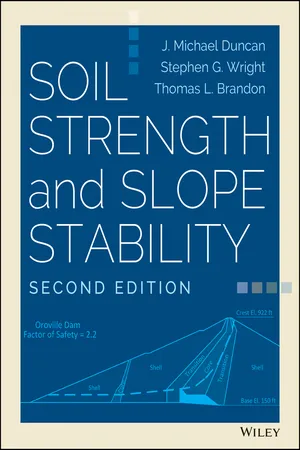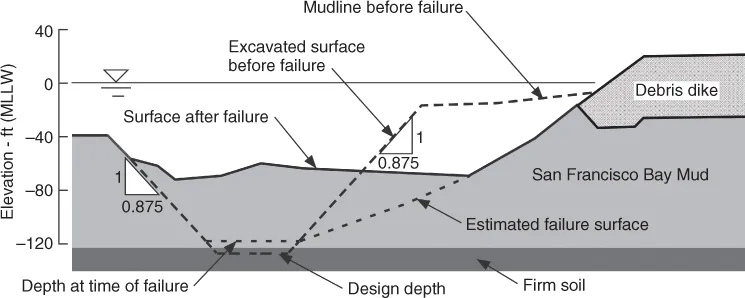
- English
- ePUB (mobile friendly)
- Available on iOS & Android
Soil Strength and Slope Stability
About this book
Soil Strength and Slope Stability, Second Edition presents the latest thinking and techniques in the assessment of natural and man-made slopes, and the factors that cause them to survive or crumble. Using clear, concise language and practical examples, the book explains the practical aspects of geotechnical engineering as applied to slopes and embankments. The new second edition includes a thorough discussion on the use of analysis software, providing the background to understand what the software is doing, along with several methods of manual analysis that allow readers to verify software results. The book also includes a new case study about Hurricane Katrina failures at 17th Street and London Avenue Canal, plus additional case studies that frame the principles and techniques described.
Slope stability is a critical element of geotechnical engineering, involved in virtually every civil engineering project, especially highway development. Soil Strength and Slope Stability fills the gap in industry literature by providing practical information on the subject without including extraneous theory that may distract from the application. This balanced approach provides clear guidance for professionals in the field, while remaining comprehensive enough for use as a graduate-level text. Topics include:
- Mechanics of soil and limit equilibrium procedures
- Analyzing slope stability, rapid drawdown, and partial consolidation
- Safety, reliability, and stability analyses
- Reinforced slopes, stabilization, and repair
The book also describes examples and causes of slope failure and stability conditions for analysis, and includes an appendix of slope stability charts. Given how vital slope stability is to public safety, a comprehensive resource for analysis and practical action is a valuable tool. Soil Strength and Slope Stability is the definitive guide to the subject, proving useful both in the classroom and in the field.
Frequently asked questions
- Essential is ideal for learners and professionals who enjoy exploring a wide range of subjects. Access the Essential Library with 800,000+ trusted titles and best-sellers across business, personal growth, and the humanities. Includes unlimited reading time and Standard Read Aloud voice.
- Complete: Perfect for advanced learners and researchers needing full, unrestricted access. Unlock 1.4M+ books across hundreds of subjects, including academic and specialized titles. The Complete Plan also includes advanced features like Premium Read Aloud and Research Assistant.
Please note we cannot support devices running on iOS 13 and Android 7 or earlier. Learn more about using the app.
Information
Chapter 1
Introduction



Summary
- We learn our most important lessons from experience, often from experience involving failures. The state of the art is advanced through these failures and the lessons they teach. As a result, the methods we use depend strongly on experience. In spite of the fact that our methods may have a logical background in mechanics and our understanding of the behavior of soils and rocks, it is important to remember that these methods are semiempirical. We depend as much on the fact that the methods have worked in the past as we do on their logical basis. We cannot count on improving these methods by altering only one part of the process that we use.
- We should not expect that we have no more lessons to learn. As conditions arise that are different from the conditions on which our experience is based, even in ways that may at first seem subtle, we may find that our semiempirical methods are inadequate and need to be changed or expanded. The slide in Waco Dam served clear notice that conventional methods were not sufficient for evaluating the shear strength of Pepper shale and the stability of embankments founded on it. The lesson learned from that experience is now part of the state of the art, but it would be imprudent to think that the current state of knowledge is complete. We need to keep abreast of advances in the state of the art as they develop, and practice our profession with humility, in recognition that the next lesson to be learned may be lurking in tomorrow's project.
Chapter 2
Examples and Causes of Slope Failures
2.1 Introduction
2.2 Examples of Slope Failure
2.2.1 T...
Table of contents
- Cover
- Title Page
- Copyright
- Preface
- Foreword
- Chapter 1: Introduction
- Chapter 2: Examples and Causes of Slope Failures
- Chapter 3: Soil Mechanics Principles
- Chapter 4: Stability Conditions for Analysis
- Chapter 5: Shear Strength
- Chapter 6: Mechanics of Limit Equilibrium Procedures
- Chapter 7: Methods of Analyzing Slope Stability
- Chapter 8: Reinforced Slopes and Embankments
- Chapter 9: Analyses for Rapid Drawdown
- Chapter 10: Seismic Slope Stability
- Chapter 11: Analyses of Embankments with Partial Consolidation of Weak Foundations
- Chapter 12: Analyses to Back-Calculate Strengths
- Chapter 13: Factors of Safety and Reliability
- Chapter 14: Important Details of Stability Analyses
- Chapter 15: Presenting Results of Stability Evaluations
- Chapter 16: Slope Stabilization and Repair
- Appendix A: Slope Stability Charts
- Appendix B: Curved Shear Strength Envelopes for Fully Softened Shear Strengths and Their Impact on Slope Stability Analyses
- References
- Index
- End User License Agreement